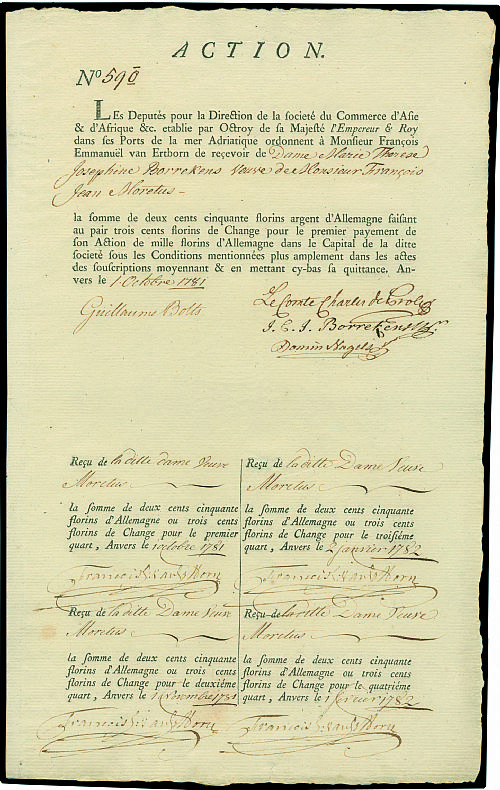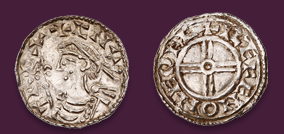
Auction: SW1008 - Bonds and Share Certificates of the World
Lot: 229
La Société du Commerce d'Asie & d'Afrique. Share 1'000 Guilders, Antwerp, 1. October 1781. Nr. 590. The share is signed by Le Comte Charles de Proli and Guilleaume (William) Bolts. Receipt for the 4 payment of 250 Guilders between 1. October 1781 and 1. February 1782. EF. Rivalry among the syndicates impacted heavily upon profits. This resulted in the foundation of the “Ostend East-India Company”, chartered by Karl VI in 1722. In a treaty with Spain, the Emperor managed to get his Company accepted by Spain, which even promised protection to its ships. The directors of the Company were chosen from amongst the rich and skilled merchants or bankers who had been involved in the previous private expeditions. The capital of the Company was fixed at 6 million Guilders, composed of 6,000 shares of 1,000 Guilders each. However, only 4.5 Million Guilders where subscribed. The money was mainly supplied by wealthy inhabitants of the cities of Antwerp and Ghent. The Company had the logo “Dum spiro, spero” - “As long as I breath, I hope” Cicero, ad Atticum 9,11. The ships used for the East India trade were generally large three-masters of the frigate-type, heavily armed and measuring several hundreds of tons. Between 1724 and 1732 the Company sent out 21 vessels, mainly to Canton (China) and to Bengal. Thanks to the rise in tea prices, high profits were made in the China trade. In total the Company paid 166 percent dividend. The Keyserlich Indische Compagnie was a thorn in the side of the older rival companies, such as the Dutch VOC, the English EIC and the French CFT. They refused to acknowledge the Austrian emperor’s right to found an East India Company in the Southern Netherlands and considered the Ostenders as interlopers. International political pressure was put on the emperor. He particularly did not want to offend the British, who in 1727 had become allies to the Austrians and who raised the most vocal opposition to the new Company. So finally Karl VI sacrificed the flourishing Ostend Company for the superior interest of the Austrian dynasty and suspended the charter of the Company for seven years. The Company however, did not stop its activity completely and between 1728 and 1731 it organized a small number of illegal expeditions under the polish flag. However, the Second treaty signed in Vienna 1731 between Karl VI and King Georg II put a true final end to the Company. Great Britain accepted the “Pragmatische Sanktion“ (which ensured that the hereditary possessions of the Habsburgs could be inherited by Karl VI daughter Maria Theresia) in exchange of the definitive abolition of the Keyserlich Indische Compagnie by the Austrians. Soon Spain and the Dutch joined this treaty as well. The very last ships sailing for the Company were the two “permission-vessels” that left in 1732 to bring back staff and goods still in East India.
Estimate
SFr600 to SFr800




